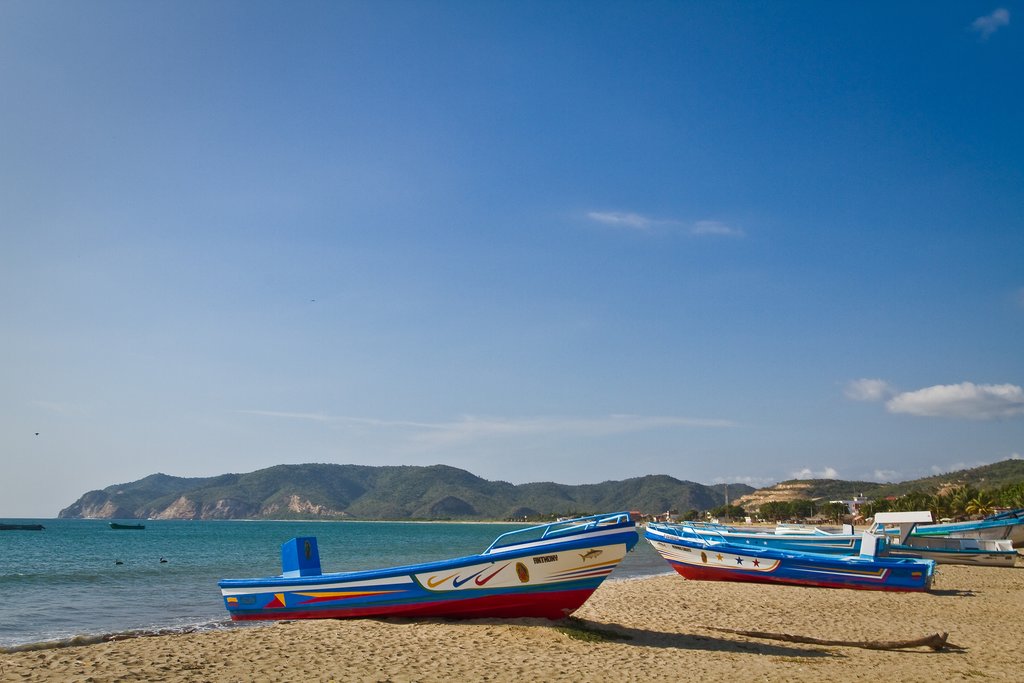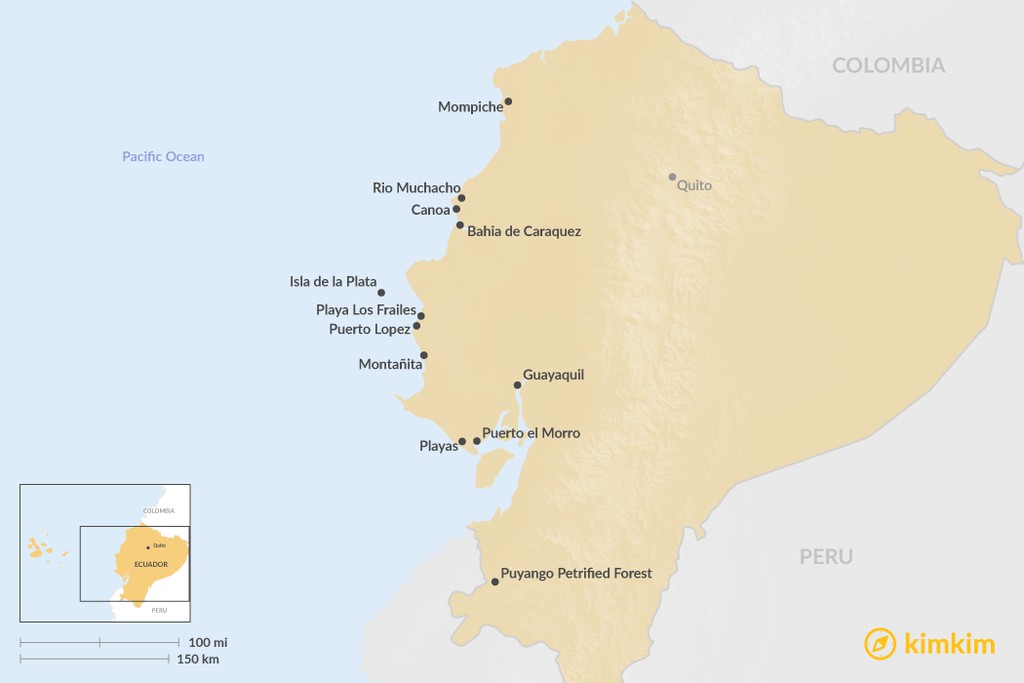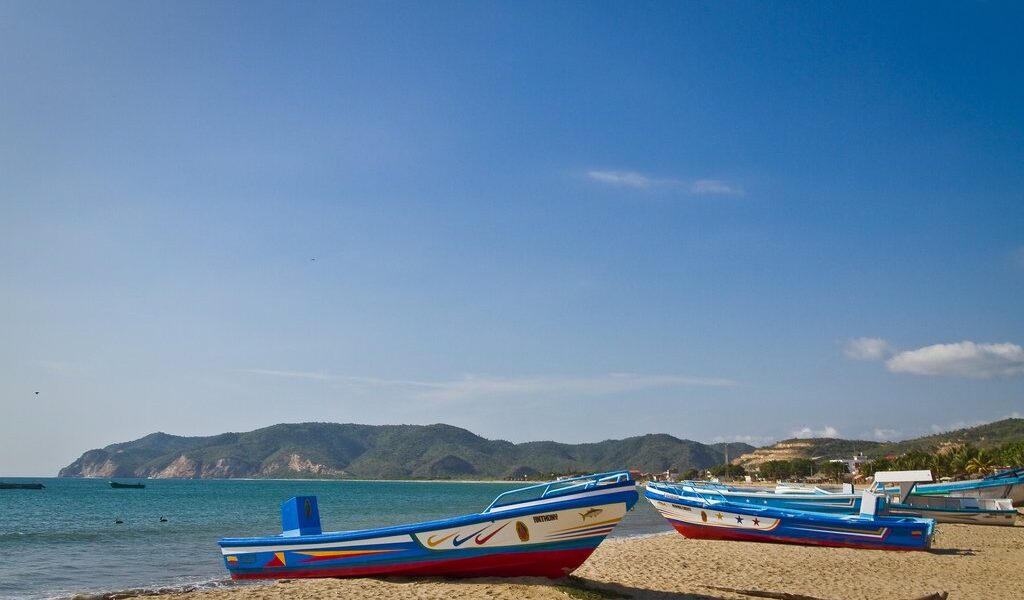
Mainland Ecuador is famous for its volcanic peaks, highland markets, and jungle wildlife, but the Pacific coast has its own range of attractions that make it worthy of a visit. Explore the regenerated waterfront of the nation’s biggest city, surf and sunbathe at a beach resort, or visit the largest petrified forest in South America: whatever you choose to do, Ecuador’s vibrant coastline won’t disappoint.
## Exploring the Enchanting Ecuadorian Coast: A Detailed Guide
Ecuador’s coastal region offers a diverse tapestry of experiences, from bustling cities to tranquil beaches, vibrant cultures to stunning natural wonders. This guide delves into the highlights of this fascinating area, providing a richer and more detailed exploration of each destination.
### Guayaquil: A City on the Rise
Guayaquil, the largest city in Ecuador and its undisputed commercial heart, presents a dynamic and ever-evolving urban landscape. While it may not possess the same abundance of colonial-era architecture as Quito, Guayaquil has carved its own distinct identity, emerging from its past as a former pirate haven to become a prominent and increasingly popular destination. Pronounced “Gwhy-akeel,” the city serves as a convenient stopover for travelers heading to the renowned Galapagos Islands and as a primary gateway to the numerous enticing beach resorts that dot the Ecuadorian coastline.
The revitalized waterfront area, known as the **Malecón**, stands as a testament to the city’s commitment to modernization and beautification. This vibrant promenade is now adorned with a plethora of historical monuments that narrate the city’s rich past. Artisan markets burst with color and craftsmanship, offering unique souvenirs and local products. Lush botanical gardens provide a tranquil escape from the urban bustle, while a towering Ferris wheel offers panoramic views of the sprawling cityscape. Museums dot the landscape, showcasing the art, history, and culture of the region.
A climb through the charming artistic district of **Las Peňas** is a must for any visitor. This neighborhood, characterized by its brightly painted houses and winding cobblestone streets, exudes a bohemian atmosphere. Reaching the lighthouse at the summit rewards you with breathtaking, sweeping views that encompass the entire city and the expansive estuary. Another highlight is the enchanting **Iguana Park**, nestled beneath the shadow of the neo-gothic cathedral. Here, hundreds of iguanas roam freely, creating a unique and memorable experience. A short distance across the river lies **Parque Histórico**, a meticulously preserved park set within a mangrove ecosystem. This natural haven allows visitors to observe caiman basking in the sun, playful monkeys swinging through the trees, and colorful parakeets flitting amidst the foliage.
### Playas and Puerto el Morro: Coastal Delights
**Playas**, despite its straightforward name, meaning simply “beaches,” holds a special place as the closest beach resort to Guayaquil. This accessibility makes it a popular destination for both locals and tourists seeking sun, sand, and sea. Similar to many other resorts in Ecuador, Playas experiences its peak activity during the high season, particularly between Christmas and Easter, when it becomes a vibrant hub of activity. However, the rest of the year offers a more tranquil and relaxed atmosphere.
The expansive beach stretches along the coastline, providing ample space for sunbathing, swimming, and various water sports. A seemingly endless row of beachside cafes tempts visitors with the aroma of freshly prepared seafood, offering a delectable array of culinary delights. The surfing conditions in Playas are also quite favorable, attracting surfers of all skill levels.
A short journey east, approximately half an hour by bus, leads to **Puerto El Morro**, a charming village renowned for its captivating boat trips through the intricate mangrove forests. These excursions provide an opportunity to witness the playful antics of dolphins as they navigate the channels, as well as observe frigatebirds and the iconic blue-footed boobies perched upon the nearby islets.
### Montañita: A Surfer’s Paradise and Party Hotspot
Approaching **Montañita**, one might jokingly suggest a sign reading “You are now leaving Ecuador,” reflecting the town’s unique international atmosphere. This hippy haven often hosts a greater number of foreign visitors than local residents, contributing to its distinctive character. Montañita is a true paradise for surfers, boasting rideable breaks that can reach impressive heights of 6-10 feet on favorable days.
For those seeking a vibrant nightlife, Montañita offers a plethora of options for drinking and dancing, particularly during the bustling weekends of the high season. The town’s reputation as a backpacker hub tends to elicit strong opinions, with visitors either falling in love with its energy or finding it overwhelming. If tranquility and restful sleep are priorities after a day of riding the waves and partying until dawn, it is advisable to seek accommodation on the outskirts of town. Fortunately, quieter resorts such as Olon are located nearby, offering a more peaceful alternative.
### Machalilla and Isla de la Plata: Natural Wonders and Whale Watching
The **Machalilla** National Park stands as one of the few protected areas along Ecuador’s coastline, preserving a stunning array of natural landscapes. The park’s hub town, **Puerto Lopez**, exudes a slightly worn charm but boasts a picturesque setting within a wide bay surrounded by rolling green hills adorned with candelabra cacti. This town serves as the ideal base for exploring the pristine, crescent-shaped **Playa Los Frailes**, widely considered to be the most beautiful beach in Ecuador, often remaining deserted and untouched.
Another popular excursion from Puerto Lopez is a boat trip to **Isla de la Plata**, located 25 miles offshore. This island, sometimes unfairly referred to as the “poor man’s Galapagos,” offers a glimpse into the unique wildlife of the region, including blue-footed boobies, various other bird species, and a small colony of playful sea lions. From June to September, the waters surrounding Isla de la Plata become a stage for the awe-inspiring spectacle of humpback whales. Scores of these majestic creatures migrate to the area, providing exceptional opportunities to witness their acrobatic displays as they breach and twirl out of the ocean.
### Bahia de Caraquez: Ecuador’s Eco-City
**Bahia de Caraquez**, often lauded as Ecuador’s most beautifully positioned city, enjoys a spectacular location on a sandy peninsula that extends from the mouth of the River Chone into the vast expanse of the Pacific Ocean. For centuries, this city served as Ecuador’s largest port, playing a vital role in the nation’s trade and commerce. However, in modern times, Bahia de Caraquez has gained recognition for its unwavering commitment to environmental practices.
The city has implemented a comprehensive recycling program, encouraging residents to minimize waste and embrace sustainable practices. Many residents and taxi drivers actively utilize bicycles as a primary mode of transportation, reducing reliance on cars and minimizing carbon emissions. Visitors to Bahia de Caraquez will find a wide array of activities to enjoy. Exploring the small beach provides a chance to relax and soak up the coastal atmosphere, although those seeking a more expansive sunbathing experience might consider venturing north to Canoa. The **Museo Banco Central** houses an impressive collection of local archaeological artifacts dating from the eighth to the fifth centuries BC, providing insights into the region’s rich history. A climb up the hill to **Mirador La Cruz** rewards visitors with breathtaking panoramic views of the city and its surroundings. For birdwatching enthusiasts, an excursion through the mangroves to **Isla Corazon** offers the opportunity to observe a large frigatebird colony in its natural habitat.
### Canoa: A Relaxed Surfing Haven
**Canoa** presents a more relaxed and laid-back alternative to the bustling party towns of Montañita, Atacames, and Salinas. The surfing conditions in Canoa are consistently good, boasting 10 miles of beach break characterized by the absence of rocks, riptides, and reefs. This makes it a popular destination for both beginners and experienced surfers alike, as well as for those interested in kite-surfing.
Most visitors come to Canoa to indulge in surfing, sunbathing, savoring fresh seafood, and enjoying the vibrant nightlife. However, beyond the town’s immediate surroundings, an interesting ecotourism excursion awaits. Ten miles north of Canoa lies **Rio Muchacho**, an organic farm that produces a variety of fruits, vegetables, jams, coffee, and chocolate. Visitors can tour the farm, enjoy horseback riding, try their hand at catching freshwater shrimp, and even create their own organic meal using fresh ingredients from the farm.
### Mompiche: Lush Landscapes and Left Point Breaks
Venturing further north along the Ecuadorian coast, the landscape becomes increasingly green and lush, signaling a transition into a more tropical environment. The small fishing village of **Mompiche** has evolved into a modest backpacker hub, attracting travelers seeking a combination of natural beauty and outdoor adventure.
The primary draw of Mompiche is its exceptional surfing conditions, boasting one of the largest left point breaks in South America. This attracts surfers from around the world, eager to test their skills on the challenging waves. Mompiche enjoys a picturesque setting, nestled amidst thickly forested hills and a beach lined with swaying palm trees. Beyond the beach, visitors can partake in horse riding adventures or embark on hikes through the verdant forests of the **Mache Chindul Reserve** inland. For those seeking a luxurious experience, a stay at the **Decameron Hotel**, perched high above the town, offers stunning views and upscale amenities.
### Puyango Petrified Forest: A Journey Through Time
The coastline south of Guayaquil remains relatively undiscovered, with many travelers simply passing through on their way to Peru. However, it is well worth making a detour to explore **Puyango**, the largest petrified forest in South America, located just five miles from the Peruvian border. This remarkable forest spans approximately 6,000 acres and, while somewhat remote, is accessible by bus from **Machala**, the self-proclaimed banana capital of the world.
The petrification process that transformed the ancient forest likely resulted from a volcanic eruption followed by a flood, creating the unique geological landscape that exists today. Along the trails within the Puyango Petrified Forest, visitors can observe fossilized plants, fish, and ammonites dating back to the Cretaceous period, embedded within the ancient tree trunks. In the surrounding tropical dry forest, keep an eye out for the diverse array of birdlife, with over 130 species recorded, including colorful parakeets.
This detailed exploration of the Ecuadorian coast offers a glimpse into the diverse experiences that await travelers, from bustling cities to serene beaches, vibrant cultures to breathtaking natural wonders. This region promises an unforgettable journey for those seeking adventure, relaxation, and cultural immersion.

B-708

